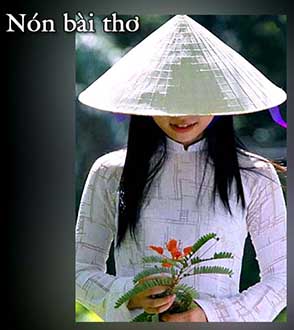Version française
 Conical hat
Conical hat
Like the tunic, the conical hat (or nón bài thơ) is also the symbol of traditional Vietnam. Contrary to the Áo Dài, the conical hat is used for a practical purpose. It is an efficient way of protection against the sun and the rain. Without this hat, you are going to be completely exhausted if you have the occasion to spend a day in the Mekong delta under the overwhelming sun.
If this hat cannot bring any grace and charm such as the case of the tunic, it represents nevertheless for the majority of Vietnamese the simplicity and the habitual practicality. It is lightweight and plaited with palm leaves. It is much used only in Huế and the countryside.
